On-Bottom Stability Analysis of Cylinders under Tsunami-Like Solitary Waves
Abstract
:1. Introduction
2. Tsunami-Like Solitary Waves
3. Experimental Tests
4. Semi-Empirical Formulas
5. Results
5.1. Surface Elevation and Kinematic Field
5.2. Hydrodynamic Forces
5.3. Calibration of Semi-Empirical Formulas
5.4. Use of Semi-Empirical Formulas
6. Conclusions
Acknowledgments
Author Contributions
Conflicts of Interest
References
- Di Risio, M.; De Girolamo, P.; Bellotti, G.; Panizzo, A.; Aristodemo, F.; Molfetta, M.G.; Petrillo, A.F. Landslide-generated tsunamis runup at the coast of a conical island: New physical model experiments. J. Geophys. Res. Ocean. 2009, 114. [Google Scholar] [CrossRef]
- Schimmels, S.; Sriram, V.; Didenkulova, I. Tsunami generation in a large scale experimental facility. Coast. Eng. 2016, 110, 32–41. [Google Scholar] [CrossRef]
- Filianoti, P.; Di Risio, M. Solitary wave loads on submerged breakwater: Laboratory tests. In Proceedings of the 22nd International Offshore and Polar Engineering Conference, Rhodes, Greece, 17–22 June 2012; pp. 1–6. [Google Scholar]
- Wu, Y.-T.; Hsiao, S.-C. Propagation of solitary waves over double submerged barriers. Water 2017, 9, 917. [Google Scholar] [CrossRef]
- Sibley, P.; Coates, I.E.; Arumugam, K. Solitary wave forces on horizontal cylinders. Appl. Ocean Res. 1982, 4, 113–117. [Google Scholar] [CrossRef]
- Chian, C.; Ertekin, R.C. Diffraction of solitary waves by submerged horizontal cylinders. Wave Motion 1992, 15, 121–142. [Google Scholar] [CrossRef]
- Xiao, H.; Huang, W.; Tao, J.; Liu, C. Numerical modeling of wave-current forces acting on horizontal cylinder of marine structures by VOF method. Ocean Eng. 2013, 67, 58–67. [Google Scholar] [CrossRef]
- Sarpkaya, T.; Isaacson, M. Mechanics of Wave Forces on Offshore Structures; Van Nostrand Reinhold Company: New York, NY, USA, 1981; pp. 1–650. [Google Scholar]
- Sumer, B.M.; Fredsoe, J. Hydrodynamics Around Cylindrical Structures; Advanced Series on Coastal Engineering; World Scientific: Singapore, 2006; pp. 1–546. [Google Scholar]
- Morison, J.R.; O’Brien, M.P.; Johnson, J.W.; Schaaf, S.A. The forces exerted by surface waves on piles. Pet. Trans. 1950, 189, 149–156. [Google Scholar] [CrossRef]
- Grace, R.A.; Zee, G.T.Y. Wave forces on rigid pipes using ocean test data. J. Waterw. Port Coast. Ocean Eng. 1981, 107, 71–92. [Google Scholar]
- Sarpkaya, T.; Rajabi, F. Hydrodynamic drag on bottom-mounted smooth and rough cylinders in periodic flow. In Proceedings of the 11th Annual Offshore Technology Conference, Houston, TX, USA, 5–8 May 1980; pp. 219–226. [Google Scholar]
- Cheong, H.F.; Jothi-Shankar, N.; Subbiah, K. Inertia dominated forces on submarine pipelines near seabed. J. Hydraul. Res. 1989, 27, 5–22. [Google Scholar] [CrossRef]
- Bryndum, M.B.; Jacobsen, V.; Tsahalis, D.T. Hydrodynamic forces on pipelines: model tests. J. Offshore Mech. Arct. Eng. 1992, 114, 231–241. [Google Scholar] [CrossRef]
- Neill, I.A.R.; Hinwood, J.B. Wave and wave-current load on a bottom-mounted circular cylinder. Int. J. Offshore Polar 1998, 2, 122–129. [Google Scholar]
- Chevalier, C.; Lambert, E.; Bélorgey, M. Efforts sur une conduite sous-marine en zone côtière. Revue Française de Génie Civil 2001, 5, 995–1014. (In French) [Google Scholar] [CrossRef]
- Aristodemo, F.; Tomasicchio, G.R.; Veltri, P. Modelling of periodic and random wave forces on submarine pipelines. In Proceedings of the 25th International Conference on Mechanics and Arctic Engineering, Hamburg, Germany, 4–9 June 2006; pp. 1–10. [Google Scholar]
- Det Norske Veritas. DNV-RP-F109, On-Bottom Stability Design of Offshore Pipelines; Det Norske Veritas: Hovik, Norway, 2010; pp. 1–41. [Google Scholar]
- Aristodemo, F.; Tomasicchio, G.R.; Veltri, P. Wave and current forces at a bottom-mounted submarine pipeline. J. Coast. Res. 2013, 65, 153–158. [Google Scholar] [CrossRef]
- Aristodemo, F.; Tomasicchio, G.R.; Veltri, P. New model to determine forces at on-bottom slender pipelines. Coast. Eng. 2011, 58, 267–280. [Google Scholar] [CrossRef]
- Kuznetsov, K.I.; Harris, J.; Germain, N.; Aristodemo, F. Modification of a Wake Model for Hydrodynamic Forces on Submarine Cables with a Rough Seabed; EGU2018-19847; Geophysical Research Abstracts: Vienna, Austria, 2018; Volume 20. [Google Scholar]
- Aristodemo, F.; Tripepi, G.; Meringolo, D.D.; Veltri, P. Solitary wave-induced forces on horizontal circular cylinders: Laboratory experiments and SPH simulations. Coast. Eng. 2017, 129, 17–35. [Google Scholar] [CrossRef]
- Liu, X.; Lin, P.; Shao, S. An ISPH simulation of coupled structure interaction with free surface flows. J. Fluids Struct. 2014, 48, 46–61. [Google Scholar] [CrossRef]
- Aristodemo, F.; Meringolo, D.D.; Groenenboom, P.; Lo Schiavo, A.; Veltri, P.; Veltri, M. Assessment of dynamic pressures at vertical and perforated breakwaters through diffusive SPH schemes. Math. Prob. Eng. 2015, 2015, 305028. [Google Scholar] [CrossRef]
- Aristodemo, F.; Marrone, S.; Federico, I. SPH modeling of plane jets into water bodies through an inflow/outflow algorithm. Ocean Eng. 2015, 105, 160–175. [Google Scholar] [CrossRef]
- Gui, Q.; Dong, P.; Shao, S. Numerical study of PPE source term errors in the incompressible SPH models. Int. J. Num. Methods Fluids 2015, 77, 358–379. [Google Scholar] [CrossRef]
- Shadloo, M.S.; Weiss, R.; Yildiz, M.; Dalrymple, R.A. Numerical simulation of long wave runup for breaking and nonbreaking waves. Int. J. Offshore Polar Eng. 2015, 25, 1–7. [Google Scholar]
- Shadloo, M.S.; Oger, G.; Le Touzé, D. Smoothed particle hydrodynamics method for fluid flows, towards industrial applications: Motivations, current state, and challenges. Comput. Fluids 2016, 136, 11–34. [Google Scholar] [CrossRef]
- Nasiri, H.; Jamalabadi, M.Y.A.; Sadeghi, R.; Safaei, M.R.; Nguyen, T.K.; Shadloo, M.S. A smoothed particle hydrodynamics approach for numerical simulation of nano-fluid flows: Application to forced convection heat transfer over a horizontal cylinder. J. Therm. Anal. Calorim. 2018, 1–9. [Google Scholar] [CrossRef]
- Rayleigh, L. On waves. Phil. Mag. 1876, 1, 257–279. [Google Scholar]
- Guizien, K.; Barthélemy, E. Accuracy of solitary wave generation by a piston wave maker. J. Hydraul. Res. 2002, 40, 321–331. [Google Scholar]
- Dingemans, M.W. Water Wave Propagation Over Uneven Bottoms; Advanced Series on Coastal Engineering; World Scientific: Singapore, 1997; pp. 1–703. [Google Scholar]
- Madsen, P.A.; Fuhrman, D.R.; Schäffer, H.A. On the solitary wave paradigm for tsunamis. J. Geophys. Res. 2008, 113, C12012. [Google Scholar] [CrossRef]
- Lee, J.J.; Skjelbreia, J.E.; Raichlen, F. Measurements of velocities in solitary waves. J. Waterw. Port Coast. Ocean Eng. 1982, 108, 200–218. [Google Scholar]
- Tripepi, G.; Aristodemo, F.; Veltri, P.; Pace, C.; Solano, A.; Giordano, C. Experimental and numerical investigation of tsunami-like waves on horizontal circular cylinders. In Proceedings of the 36th International Conference on Ocean, Offshore and Arctic Engineering, Trondheim, Norway, 25–30 June 2017; pp. 1–10. [Google Scholar]
- Mattioli, M.; Mancinelli, A.; Brocchini, M. Experimental investigation of the wave-induced flow around a surface-touching cylinder. J. Fluids Struct. 2013, 37, 62–87. [Google Scholar] [CrossRef]
- Lin, M.Y.; Liao, G.Z. Vortex shedding around a near-wall circular cylinder induced by a solitary wave. J. Fluids Struct. 2015, 58, 127–151. [Google Scholar] [CrossRef]
- Filianoti, P.; Aristodemo, F.; Tripepi, G.; Gurnari, L. Wave flume test to check a semi-analytical method for calculating solitary wave loads on horizontal cylinders. In Proceedings of the 36th International Conference on Ocean, Offshore and Arctic Engineering, Trondheim, Norway, 25–30 June 2017; pp. 1–9. [Google Scholar]
- Seiffert, B.; Hayatdavoodi, M.; Ertekin, R.C. Experiments and computations of solitary-wave forces on a coastal-bridge deck. Part I: Flat Plate. Coast. Eng. 2014, 88, 194–209. [Google Scholar] [CrossRef]
- Wolfram, J.; Naghipour, M. On the estimation of Morison force coefficients and their predictive accuracy for very rough circular cylinders. Appl. Ocean Res. 1999, 21, 311–328. [Google Scholar] [CrossRef]
- Sumer, B.M.; Jensen, B.L.; Fredsoe, J. Effect of a plane boundary on oscillatory flow around a circular cylinder. J. Fluid Mech. 1991, 225, 271–300. [Google Scholar] [CrossRef]
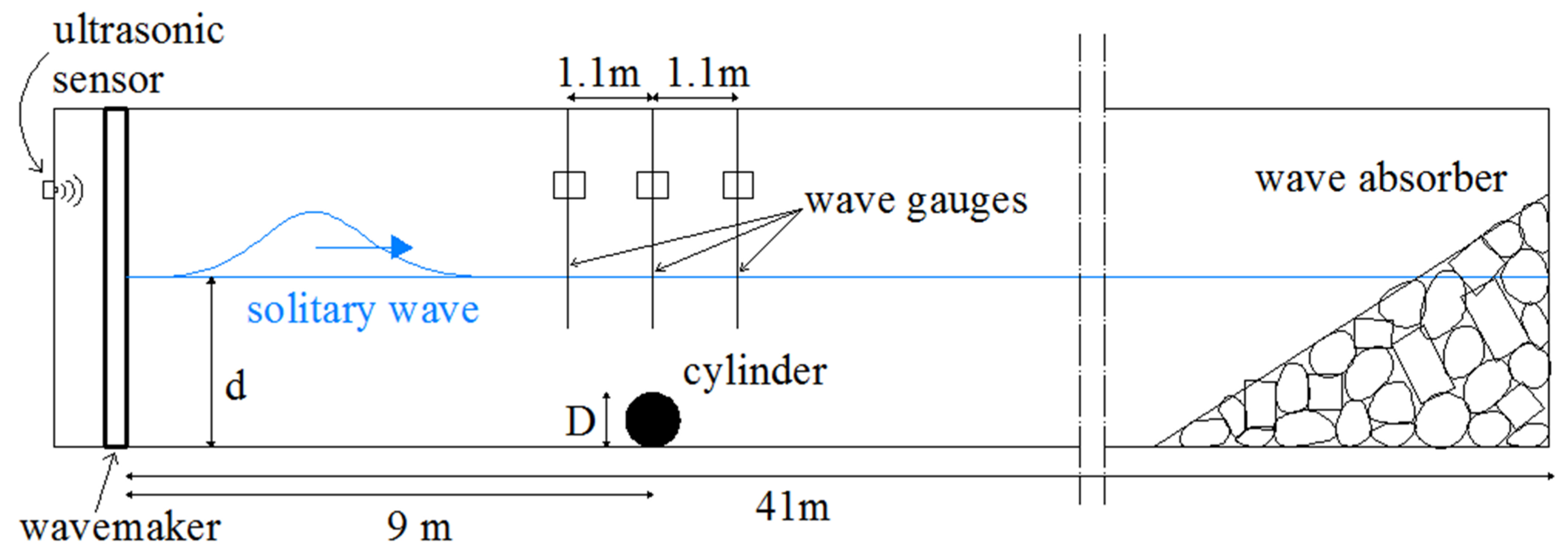
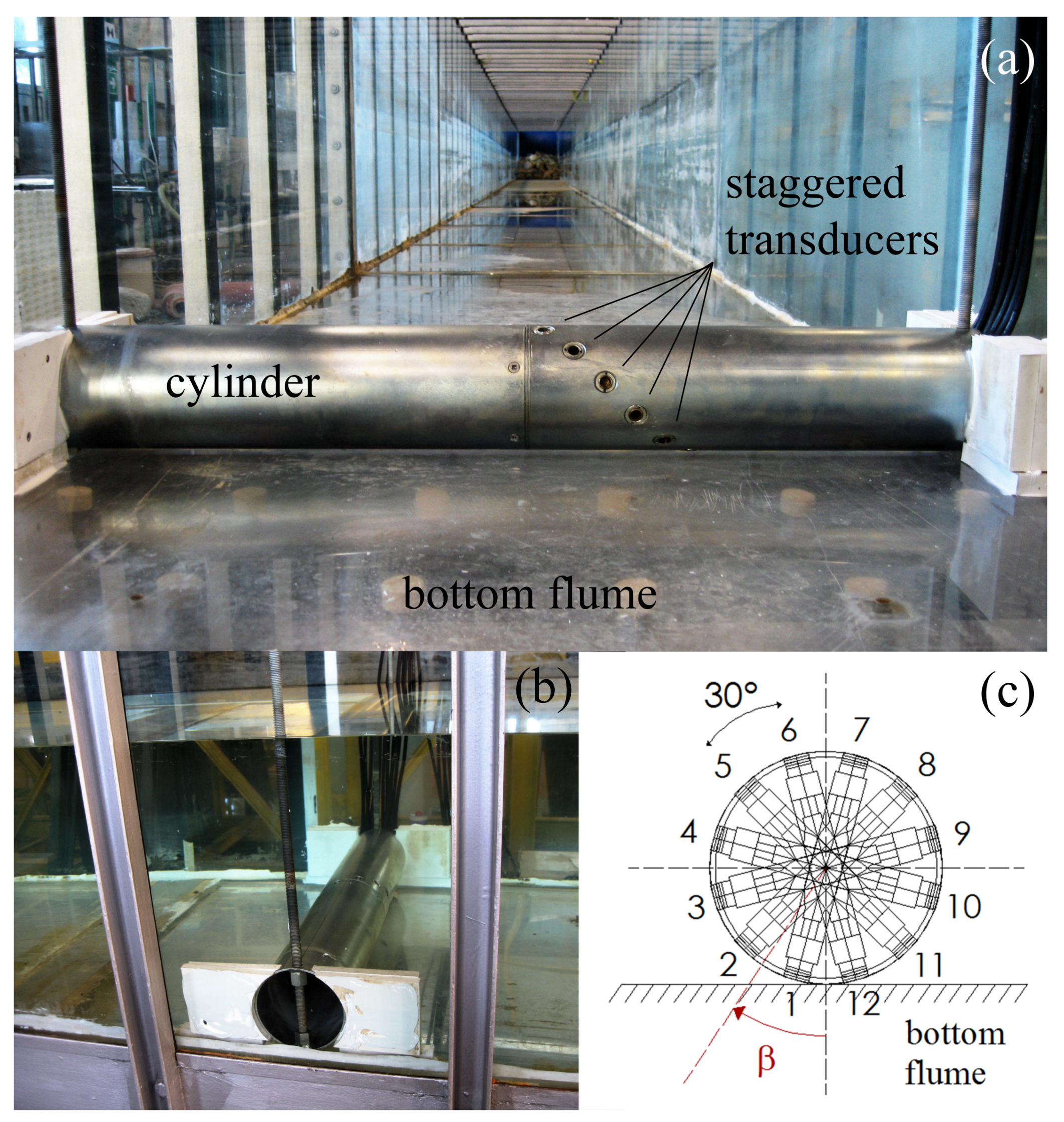




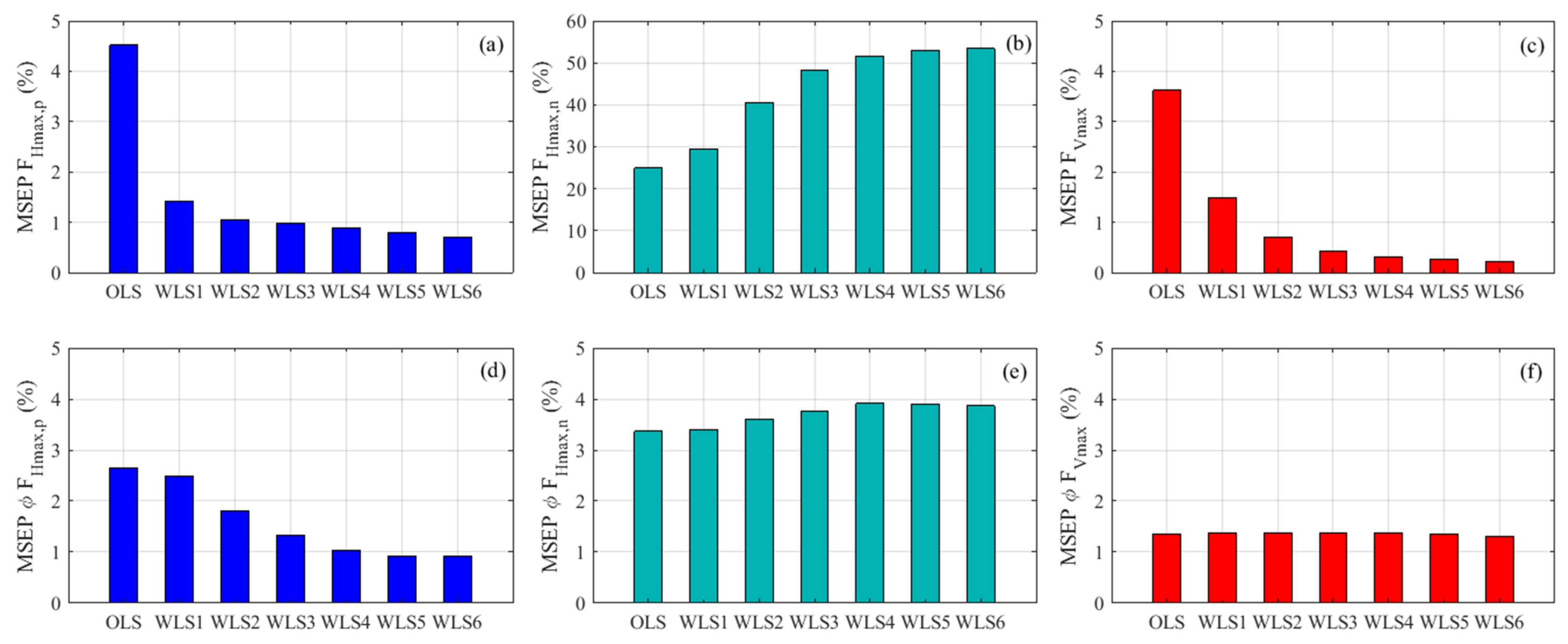
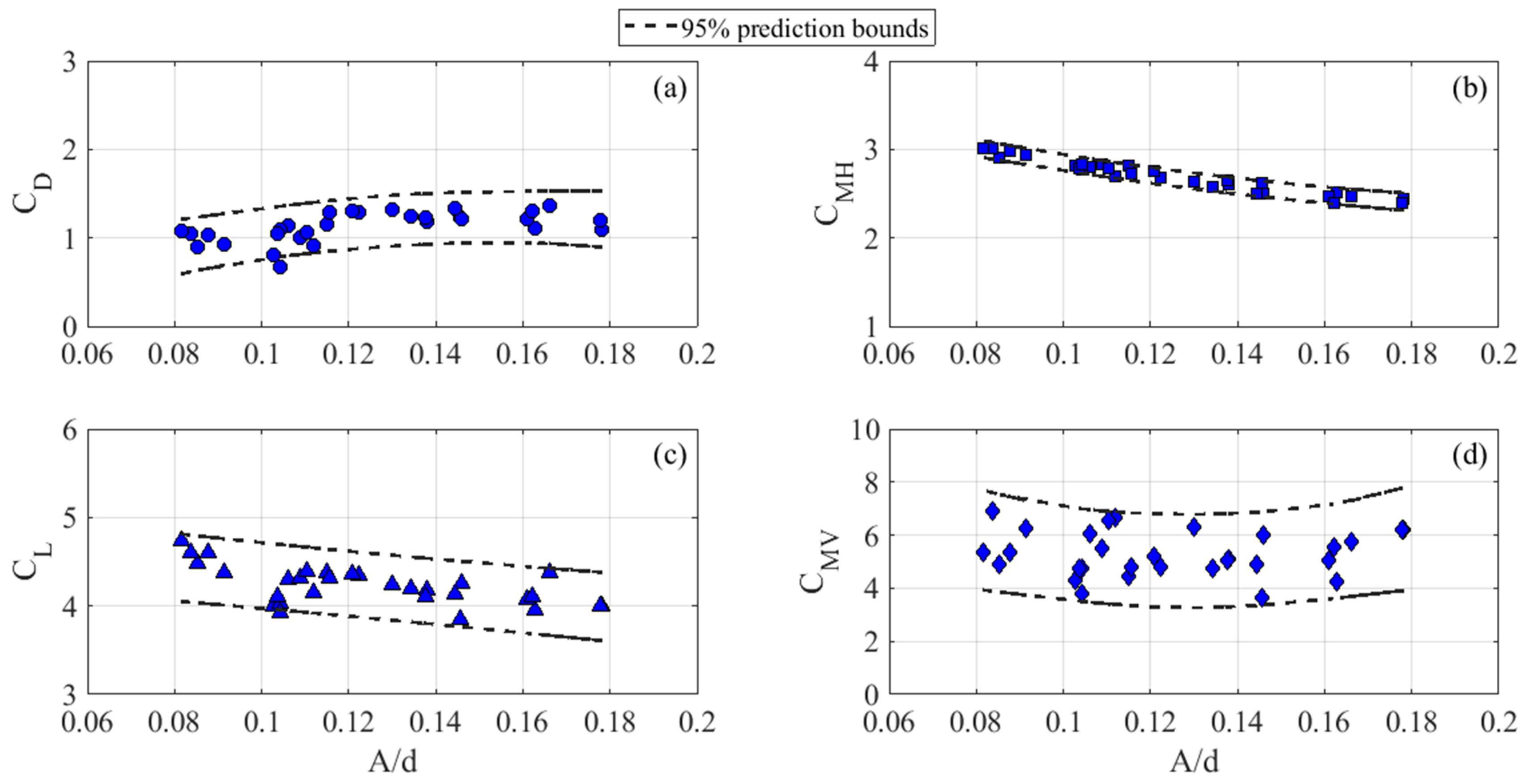
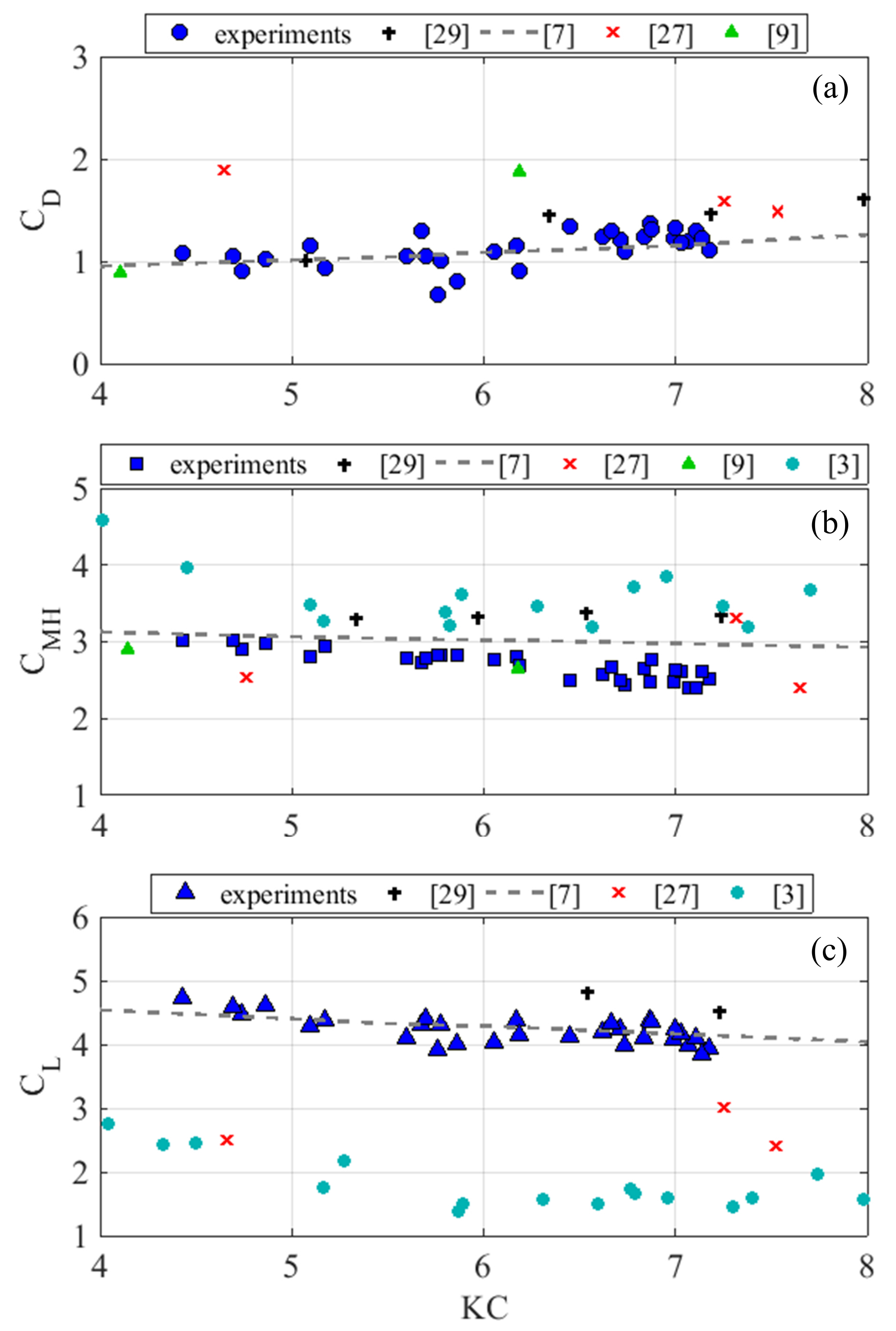
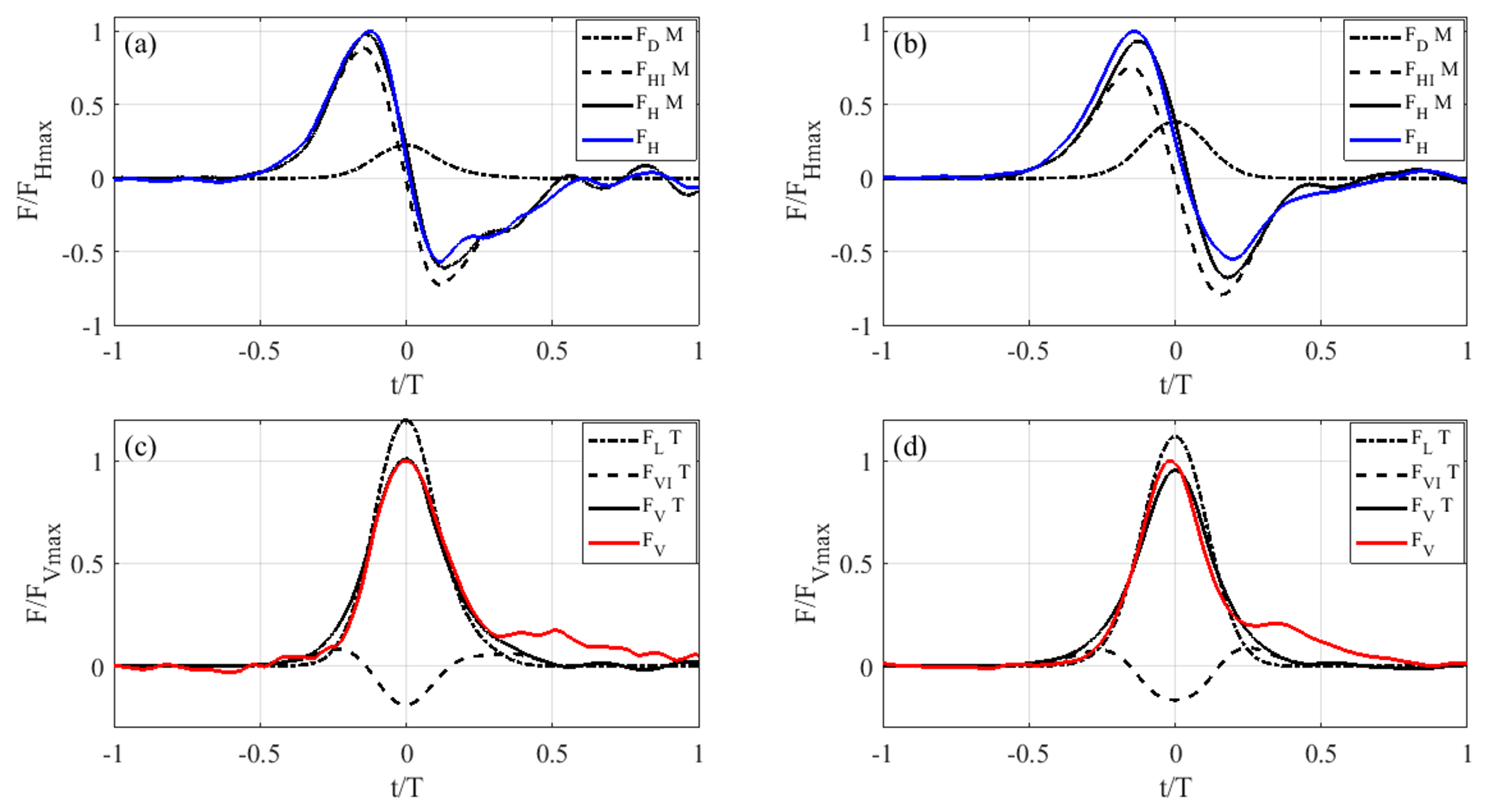

| Test Number | A (m) | T (s) | A/d | KC | Re | d/L |
|---|---|---|---|---|---|---|
| 1 | 0.033 | 3.73 | 0.083 | 4.43 | 1.83 × 104 | 0.052 |
| 2 | 0.034 | 3.84 | 0.085 | 4.69 | 1.87 × 104 | 0.051 |
| 3 | 0.034 | 3.82 | 0.085 | 4.74 | 1.91 × 104 | 0.051 |
| 4 | 0.035 | 3.83 | 0.088 | 4.86 | 1.95 × 104 | 0.051 |
| 5 | 0.037 | 3.91 | 0.093 | 5.17 | 2.03 × 104 | 0.050 |
| 6 | 0.041 | 3.99 | 0.103 | 5.86 | 2.26 × 104 | 0.048 |
| 7 | 0.041 | 3.78 | 0.103 | 5.60 | 2.27 × 104 | 0.051 |
| 8 | 0.042 | 3.87 | 0.105 | 5.76 | 2.29 × 104 | 0.050 |
| 9 | 0.042 | 4.06 | 0.105 | 6.06 | 2.29 × 104 | 0.047 |
| 10 | 0.043 | 3.37 | 0.108 | 5.10 | 2.33 × 104 | 0.057 |
| 11 | 0.044 | 3.73 | 0.110 | 5.77 | 2.38 × 104 | 0.051 |
| 12 | 0.044 | 3.64 | 0.110 | 5.70 | 2.41 × 104 | 0.053 |
| 13 | 0.045 | 3.90 | 0.113 | 6.19 | 2.44 × 104 | 0.049 |
| 14 | 0.046 | 3.79 | 0.115 | 6.17 | 2.50 × 104 | 0.050 |
| 15 | 0.046 | 3.47 | 0.115 | 5.67 | 2.51 × 104 | 0.055 |
| 16 | 0.048 | 4.05 | 0.120 | 6.87 | 2.61 × 104 | 0.047 |
| 17 | 0.049 | 3.88 | 0.123 | 6.66 | 2.64 × 104 | 0.049 |
| 18 | 0.052 | 3.86 | 0.130 | 7.00 | 2.78 × 104 | 0.049 |
| 19 | 0.054 | 3.56 | 0.135 | 6.62 | 2.86 × 104 | 0.053 |
| 20 | 0.055 | 3.59 | 0.138 | 6.84 | 2.92 × 104 | 0.053 |
| 21 | 0.055 | 3.69 | 0.138 | 7.03 | 2.93 × 104 | 0.051 |
| 22 | 0.058 | 3.26 | 0.145 | 6.45 | 3.04 × 104 | 0.058 |
| 23 | 0.058 | 3.58 | 0.145 | 7.14 | 3.06 × 104 | 0.053 |
| 24 | 0.058 | 3.36 | 0.145 | 6.71 | 3.07 × 104 | 0.056 |
| 25 | 0.064 | 3.22 | 0.160 | 6.99 | 3.33 × 104 | 0.058 |
| 26 | 0.065 | 3.26 | 0.163 | 7.11 | 3.35 × 104 | 0.058 |
| 27 | 0.065 | 3.28 | 0.163 | 7.18 | 3.36 × 104 | 0.057 |
| 28 | 0.066 | 3.09 | 0.165 | 6.87 | 3.42 × 104 | 0.061 |
| 29 | 0.071 | 3.01 | 0.178 | 7.07 | 3.61 × 104 | 0.062 |
| 30 | 0.071 | 2.86 | 0.178 | 6.74 | 3.62 × 104 | 0.065 |
© 2018 by the authors. Licensee MDPI, Basel, Switzerland. This article is an open access article distributed under the terms and conditions of the Creative Commons Attribution (CC BY) license (http://creativecommons.org/licenses/by/4.0/).
Share and Cite
Tripepi, G.; Aristodemo, F.; Veltri, P. On-Bottom Stability Analysis of Cylinders under Tsunami-Like Solitary Waves. Water 2018, 10, 487. https://doi.org/10.3390/w10040487
Tripepi G, Aristodemo F, Veltri P. On-Bottom Stability Analysis of Cylinders under Tsunami-Like Solitary Waves. Water. 2018; 10(4):487. https://doi.org/10.3390/w10040487
Chicago/Turabian StyleTripepi, Giuseppe, Francesco Aristodemo, and Paolo Veltri. 2018. "On-Bottom Stability Analysis of Cylinders under Tsunami-Like Solitary Waves" Water 10, no. 4: 487. https://doi.org/10.3390/w10040487






